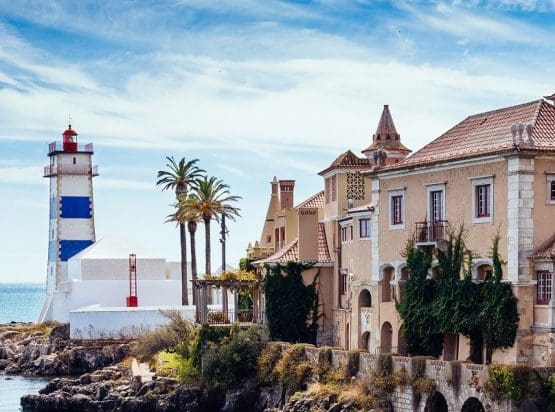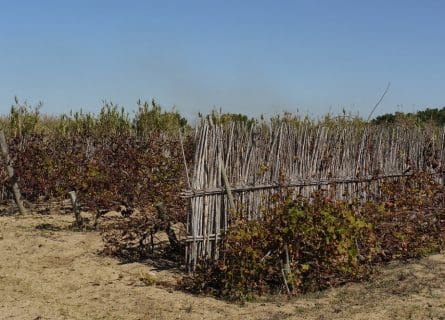Uncover Cascais's vibrant flavors and culinary gems with our expert guides. Plan an unforgettable trip now!
Read more
EXPLORE ALL OUR GUIDES TO PORTUGAL'S WINE REGIONS
Last updated: December 9, 2023
Colares was once a giant of the Portuguese viticulture. Justly renowned for its potent red wines, rigid with tannin, Colares was shipped to all corners of the world. Indeed, the vineyards of Lisboa were the engine of the nation’s export industry in the Middle Ages, enjoyed by wine lovers across northern Europe. Meanwhile, the Douro was merely a mosquito-infested wasteland. And Alentejo? Considered an unsuitable place to grow vines: too arid and isolated. For a time, Colares was Lisbon’s undisputed red wine celebrity, referred to as the ‘Bordeaux of Portugal.’
Sadly, fortune did not favor the bold. Like its neighbors, Carcavelos and Torres Vedras, Colares has been a victim of 20th-century urban sprawl as real estate developers gobble up huge swathes of land along the Atlantic coast. Today, Colares is a very small DOC on the sandy coast west of Lisbon – a shadow of its former self. Yet the rising demand for authentic wines and esoteric grapes has led to a small revival in fortune. An emerging generation of producers increasingly take great pride in these ancient, maritime-influenced wines. After a long hibernation, Colares is reawakening.
The great powers of the ancient world were all drawn to the majestic landscapes of central Portugal. The Phoenicians were the first to establish colonies in the Iberian Peninsula, followed by the Greeks; both were extraordinarily keen on planting vines. However, the Romans built a lasting legacy in Colares, bringing roads, aqueducts, sanitation, and a sophisticated political system to local society. Their farmers, meanwhile, covered the landscape with vineyards. But the Roman idea of a good vintage would surely horrify today’s oenophiles; sugar, water, and herbs were added to the fermented grape juice, which was then cooked for several days. It presumably tasted like a cross between Madeira and mead.
Then it all fell apart. Rome’s enemies had been gaining strength for over a century, culminating in the sacking of the capital in 410 by the Visigoth king Alaric. Several decades later, the entire Western Roman Empire ceased to exist. Europe was once again a fragmented land of competing fiefdoms and kingdoms, with every territory up for grabs. Yet the Alans, Vandals, and Sumerians all failed to conquer the Iberian Peninsula, despite numerous attempts. That honor was left to the Suebi, a tribe from northern Europe. However, the Visigoths crushed the Suebi’s armies in 585, gaining control of the peninsula.
They were subsequently displaced by the forces of Tariq, a Moorish general who landed troops in Andalucia in 711. As a result, life in the Iberian Peninsula was once again transformed as the Moors disseminated their architectural preferences, gastronomic traditions, faith, and technological prowess. Interestingly, the land surrounding Colares was briefly occupied by the Norwegian king Sigurd 1, who had embarked on a crusade to the Holy Land in the 12th century. Yet by 1147, Lisbon and the environs were liberated from outside influences by Afonso Henriques.
Wine production in Colares reached a golden age during the 18th century after Portugal’s chief minister, the Marques de Pombal, modernized the nation’s vineyards. Moreover, when phylloxera was busy devastating regions across Western Europe in the 1800s, Colares remained unaffected; the louse could not survive in the sandy soils of the zone. Thus, total production increased during phylloxera, rising to over 1.5 million hectoliters. Of course, the picture looks very different in 2023: the total acreage has shrunk considerably. Fortunately, reports of the death of this antique wine style have been grossly exaggerated. A resurgence is well underway.

The vineyards of Portugal’s Atlantic coastline are among the prettiest in Europe. Flanked by whitewashed villages and cliffs, Colares is as much a seaside resort as it is a wine producer. The vines are only three kilometers east of the Atlantic, northwest of the capital Lisbon. At the spectacular Cabo de Roca vantage point (the westernmost place in continental Europe), you can watch the fishing fleets return to port every afternoon. The spirit of Cabo de Roca is timeless; Portugal’s leading poet, Luis de Camões, described it simply as a place “where the land ends and the sea begins.”
Colares’ signature red grape is Ramisco, rich in tannin and extract. A late-ripening variety, Ramisco needs plenty of sunlight to reach optimal phenolic ripeness; the mild climate of Colares necessitates a long growing season. However, while marine air from the Atlantic can be a godsend in August, torrential rains can be a real headache during the fall. In difficult years, an ill-timed deluge can wipe out the entire harvest in Colares due to the onset of rot. Meanwhile, the cooling winds that blow from the ocean come with a hidden cost: salt. Fortunately, winegrowers use dried-reed fences to protect their crops from the winds and salt.
The local terroir is famous across Portugal: free-draining and phylloxera-free sandy soils that support a population of ungrafted vines. Drainage is key here due to the inclement weather that defines spring and even early summer in Colares. However, cultivating vineyards in sandy terroir is a mixed blessing. On the plus side, these loose-grained soils allow excessive moisture to pass through very quickly; waterlogging can be a real issue in the porous (but not permeable) clay soils of St-Emilion, for example. Yet in dry years, sandy terrain will not store vital moisture – nutrients are thin on the ground as well. But underneath the sandy soils of Colares are the porous ‘chão rijo’ clays that make viticulture possible here. Without them, the region could not produce high-quality wine.
Demarcated in 1908, Colares DOC (Denominação de Origem Controlada) boasts the oldest wine co-operative in Portugal: the Adega Regional de Colares. Founded in 1931, it once counted over 500 different growers as members, cultivating 2,000 hectares of vines. Yet while the acreage – and the number of winegrowing families – has declined significantly, Corales is far from irrelevance today. Traditionally, the red and white grapes of the region were sent to the Adega Regional to be processed, as most farmers lacked even basic winemaking equipment. At the expansive premises of the co-operative, berries were crushed and foot-stomped in the Lagares (giant concrete baths) before they were fermented in wood. Stainless steel is a relatively modern part of Portugal’s winemaking industry – wines were classically fermented in gigantic oak vats, ranging from 500 to 10,000 liters.
However, at least one of the region’s producers uses temperature-controlled vinification to fashion a gentler style of Ramisco without the astringent tannin that once defined Colares reds. Nevertheless, wood still plays a vital role in wine maturation across the DOC, not least at the Adega Regional. The co-operative’s Malvasia whites, saline and pungent, are aged eight to ten months in large vats, although the barrels are not oak; mahogany and kambala are both favored. As a result, what emerges in your glass is waxy and intense, with garrigue, lychee, and citrus aromas. But red wines, aged for three years in this exotic wood, are also matured in smaller French barrique. This helps to soften the fierce tannins of Ramisco, enhancing complexity into the bargain. That way, you get the best of both worlds: an approachable wine that will age gracefully for many years.
It’s very hard to stand in a Colares vineyard, where the wind whistles around your ears and chills your fingers, and not marvel at the renaissance of this unique wine style. Investors such as José Beata (owner of Adega Viúva Gomes) and the late Baron Bodo von Bruemmer have pulled off a remarkable feat, rescuing the appellation from near extinction. Indeed, by the late-1990s, it appeared that every last acre would be sold to property magnates. Yet a few stubborn growers held out, joined by the region’s venerable Adega Regional. They believed that the burgeoning demand for authentic Portuguese wines would give Colares a new lease of life in the 21st century. They were right.
One reason for its resurgence is the abundance of ungrafted bush vines in the zone – wine geeks go crazy for these rare parcels of centenarian vines. In Colares, however, working with these delicate plants is deemed obligatory under the law. According to the DOC framework, growers must cultivate bush vines planted in sandy soils. This precious asset has been an important part of the campaign to entice sommeliers – and buyers – into finding room for Colares in their portfolios. Neither is the style’s moderate alcohol and beautiful freshness a hindrance when presenting the latest vintage to prospective clients. The marketing epithet “authentic,” a word overused by corporate publicists, is nonetheless entirely appropriate. Where else can you find such a unique flavor profile – a mosaic of salinity, minerals, citrus, and garrigue in the whites? Which other DOC habitually matures its wines in mahogany or rosewood?
The small volume of Malvasia whites are so attractive young that their keeping qualities are not often explored enough, albeit this is slowly changing. But the best Ramisco is a real keeper: everything from ten to fifty years. As a rule, in poor years, Colares reds can be astringent and sharp, but in the best years, like 2015, they can surpass every other Portuguese red for elegance, depth, and longevity. Exports, of course, are a mere drop in the ocean. But that’s no reason not to try these amazing wines.
Arinto is a versatile white wine grape variety known for its crisp acidity, citrus, green apple flavors, and a mineral finish
Find out moreMalvasia Bianca, a historical grape from Greece, now thrives in Sicily and the Aeolian Islands, producing unique sweet wines.
Find out moreRamisco is a rare red grape variety grown in the Colares region of Portugal, known for producing deeply colored and tannic wines
Traveling just a few kilometers west of Sintra, you’ll arrive at Lisbon’s biggest gastronomic secret. Colares is fortunate to host a number of excellent restaurants, and venues that have an advantageous relationship with the local fishermen; the best of the catch is always reserved for regulars. That fact, combined with the relative lack of tourists, has created a paradise for lovers of fresh seafood. Every dish will be cooked to perfection: locally sourced ingredients are prepared according to time-honored recipes. In Colares, molecular gastronomy has no place in the hearts and minds of local gastronomes. We suggest you join them.

Uncover Cascais's vibrant flavors and culinary gems with our expert guides. Plan an unforgettable trip now!
Read more
Uncover Lisbon's vibrant flavors and culinary gems with our expert guides. Plan an unforgettable trip now!
Read more
Uncover Sintra's vibrant flavors and culinary gems with our expert guides. Plan an unforgettable trip now!
Read moreIf you would like us to customize an exclusive luxury tour, contact us and let us know your travel plans. We offer luxury food and wine tours for private groups of a mininium two guests. In addition, all of our private, chauffeured tours are available year-round upon request.

